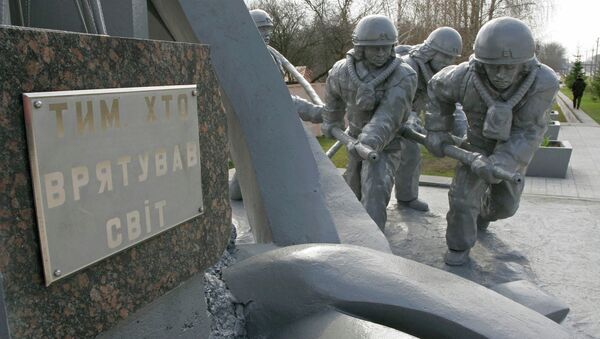Two loud blasts broke the silence of the night at the Chernobyl Nuclear power plant on April 26, 1986. Minutes after the incident, 28 firefighters stationed at the plant were deployed to put out the fire inside the partially destroyed Reactor Unit 4 building. Its roof was damaged and ablaze, placing other facilities, including Unit 3, in danger.
Firefighters, led by their chief Leonid Telyatnikov, quickly reached the epicenter. It took them several hours to extinguish the flames.
According to Matvey Shavrey, member of the Chernobyl Power Plant fire crew, he and his comrades immediately felt the fatal effects of radiation sickness:
“Together with Alexander Petrovsky, I went straight to the roof of the reactor building. On our way we met the guys from Special Firefighters Unit 6, they were seriously unwell. We walked them to the ladder and went back to the epicenter, where we stayed until we put out the flames. Upon completion of the work we walked downstairs where we were picked up by the ambulance. We were in very bad shape as well.”
Most of the 28 first responders, including Leonid Telyatnikov received high doses of radiation and either died immediately after the Chernobyl disaster, or suffered from various illnesses, including thyroid and brain cancer for years.
Besides firefighters there were helicopter pilots who managed to place radiation detectors on the roof of the damaged reactor, ambulance crews who came to rescue, hundreds of bus and truck drivers who helped evacuate the population of the nearby Pripyat – nowdays a famous ghost town.
The term “Liquidator” appeared in the news almost immediately, officially defined as “participant in liquidation of the Chernobyl Nuclear Power Plant accident consequences”. People from all over the Soviet Union, from Ukraine, Belarus, the Russian Federation and other republics were part of the operation.
Within the next 7 months the so-called “Shelter Object”, or Chernobyl Nuclear Power Plant sarcophagus was built from concrete to prevent radioactive elements from contaminating the atmosphere.
But the hastily built structure was not meant to be in place for more than a few decades, so eventually it had to be replaced with a tougher modern object – the so-called New Safe Confinement, or The Arch.
The project is currently under way and it’s being financed through the European Bank of Reconstruction and Development’s Chernobyl Shelter fund. It’s expected that once fully assembled, a 92.5 meter-tall movable structure – the biggest of its kind in human history, will be carefully placed over the reactor building. It’s designed to be able to contain the radiation for the next 100 years.
Here’s Dr. Najmedin Meshkati, a Professor of Civil and Environmental Engineering at the University of Southern California talking about The Arch in an interview to RT:
“I think that the intent of this new sarcophagus, this new safe confinement, as they say, is to basically entomb the old sarcophagus and it’s gonna be a climate-controlling structure because they wanna reduce the moisture inside, reduce the corrosion effect.”
According to the World Health Organization, more than 240,000 rescue workers were called upon during the peak period of recovery projects in 1986 and 1987, and a total of 600,000 people registered as Chernobyl veterans.
And since the construction of the new safe confinement is yet to be finished, with 100% completion scheduled for 2017, it appears that the number of people who can call themselves liquidators of the Chernobyl nuclear disaster, will grow.


